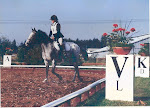THE SPIRIT OF DRESSAGE by Lee Ziegler, copyright Jan. 1997
Excerpt: WHAT IS THE TRUE SPIRIT OF DRESSAGE?
Contrary to popular belief, dressage is not about riding tests and doing abstruse movements on huge horses in fancy clothes. Dressage started as a very practical, scientific, methodical training regimen to produce sound, supple, responsive horses for use in war, then later in spectacles called carrousels. Eventually, it evolved into an art, which our modern society was unable to grasp and replaced with sport, so we now pursue test-oriented training and have largely forgotten the origins of the discipline, or the art that it can be. (The art still survives in small enclaves in Portugal, France and Vienna, but the artists are not out riding tests.) Fortunately, we aren't training horses for war anymore, but the same methods that produced practical, useful horses for the battlefield can produce useful horses for everyday trail and show riding, whether the horses involved trot like the sport horses or not.
So, while we are not going to be riding dressage tests designed for trotters on our gaited horses, that does not mean that we don't want supple, sound, responsive horses. Most of the exercises developed for basic dressage work nicely for us, as long as we do them only in the ordinary and flat walk, not the running walk. (The running walk presents balance and flexibility problems in tight circles and lateral movements.) Circles work for us because they develop balance and strength in the back. Serpentines work for us because they develop flexibility. Spirals work for us, because of the balance and strength they develop. Shoulders-in work for us, again developing balance, strength in the hind quarters, and looseness in the shoulders, a very desirable trait in a Walker. Haunches-in work for us, developing flexibility through the body. Only after we have built up our horses through these basics, working on strengthening the back, haunches and shoulders do we really get the kind of stride lengthening we want, flowing out of a strong back. Dressage really works for Walkers, but apply the spirit, not the letter of modern "sport" Dressage. Use the exercises it includes to help your horse carry his body and your weight better, without sagging his back or making his vertebrae impinge, and he will stay sound. Use school figures and progressive training to condition your horse and he will be more supple, able to negotiate rough ground on a trail, or make the corners in an arena at speed without "hopping". Apply the aids and do the progressively more difficult figures of basic dressage and your horse will be more responsive, listening to you and doing what you ask. Dressage isn't about tests, it's about intelligent, biomechanically sound training for use. And it definitely is for Walking Horses.
http://www.walkinonranch.com/media/6_2007_MNFS_Rev_7-07.wmv
I don't teach about horses, the horses do the teaching...if only we would listen to them.

Donna DeNoble
Sunday, February 3, 2008
Subscribe to:
Post Comments (Atom)







No comments:
Post a Comment